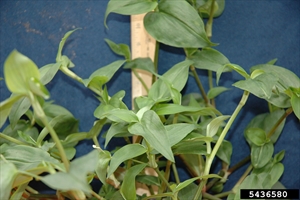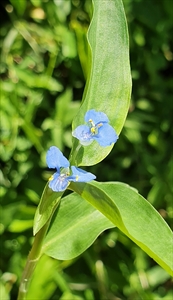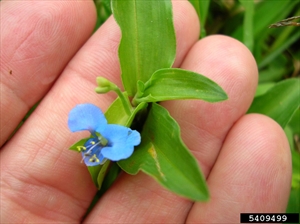Commelina; it is also known as wandering Jew, baby dayflower, or scurvy weed. CABI prefers the name spreading dayflower.
Pacific Pests, Pathogens and Weeds - Online edition
Pacific Pests, Pathogens & Weeds
Commelina (460)
Commelina diffusa. It has also been known as Commelina nidiflora and Commelina communis. It is similar to another plant also called wandering Jew, Commelina benghalensis. It is a member of the Commelinaceae.
Asia, Africa, North, South and Central America, Oceania. It is recorded from Australia, Fiji, and Papua New Guinea. It is native to tropical Asia, Australia and Polynesia.
An important long-lived, invasive, much-branching, creeping weed of plantations, orchards, vegetable fields, wet pastures, field borders, roadsides, gardens and wasteland, in tropical, sub-tropical, and warmer temperate regions. It occurs mainly in open, moist habitats with disturbed soils. The weed is able to withstand saturated conditions and temporary flooding, including rice paddies.
Commelina has soft, smooth, fleshy stems, up to 100 cm long, producing roots at swelling where leaves form (nodes) when in contact with soil (Photo 1). Leaves, 4-6 cm long, elongate with pointed tips, alternate along the stems, with a 1-2 cm sheath at the base enclosing the stem. Hairs are present on the margins of the leaves. Flowers, in small clusters in the upper leaf forks with a folded leaf-like structure (bract) below (Photos 2&3). There are three bright blue (rarely white) petals. Each flower has three fertile yellow stamens (male parts), and an ovary topped with a slender blue style (female part). Flowers open only in the morning. The fruit has five dark-brown seeds.
Commelina spreads vegetatively via its creeping stems, and by its seeds. Seeds and stem pieces are spread by water and also in contaminated soil. It has been spread long distances as an ornamental, and also as a medicinal plant.
It is mostly a problem in young crops during the first 2-5 weeks; but it can also spread from the margins into mature crops. CABI lists a number of crops where it is a problem, for instance: banana (Mexico, Hawaii, the Philippines, cocoa (Cameroon), sugarcane (Mexico, Trinidad, Puerto Rico), coffee (Costa Rica, Mexico), pineapple (Philippines), papaya (Hawaii, the Philippines), forest nurseries and citrus (Japan, Mexico), vegetables (Mexico), sorghum (Thailand), maize (Colombia), and rice (Mexico, USA).
It is an ornamental. It is also used medicinally in China to reduce fevers, and in Hawaii to treat deep cuts. A dye is extracted from the flowers. The young tips are eaten in Papua New Guinea.
BIOSECURITY
The risk of introduction is moderately high. Countries not yet infested should consider all likely pathways for entry, and apply quarantine measures accordingly. Particular attention should be given to the risks associated with the weed as an ornamental. Seed is available for sale on the internet.
BIOCONTROL
No attempts at control reported.
CULTURAL CONTROL
- Physical & Mechanical
- Hand weed. A difficult weed to control manually as small pieces regrow. Pulling or hand-hoeing is frequently used to control this weed.
- Cultivate. Mechanical as well as animal-drawn cultivators are used commonly against this weed.
- Plough, to give temporary control.
- Cover crops
- Cultivation of a cover crop can be used to smother emerging and established plants. Increasing the density of leguminous crops and doubling the rows of maize to shade out commelina can also be advantageous.
CHEMICAL CONTROL
In Australia, a number of herbicides are registered for the control of Commelina species, for instance: bentazone; glyphosate; fluroxypyr; pendimethalin. Commelina is not well controlled by 2,4-D or glyphosate. In Fiji, metsulfuron-methyl.
--------------------
Note, EU approval to use glyphosate ends in December 2022; its use after that date is under discussion.
____________________
When using a pesticide, always wear protective clothing and follow the instructions on the product label, such as dosage, timing of application, and pre-harvest interval. Recommendations will vary with the crop and system of cultivation. Expert advice on the most appropriate herbicides to use should always be sought from local agricultural authorities.
AUTHORS Grahame Jackson, Aradhana Deesh & Mani Mua
Adapted from Wandering Jew (Commelina diffusa) (2018) Weeds of SE Qld and Northern NSW. Lucidcentral. (https://www.lucidcentral.org/editors-pick-animal-and-plant-identification-keys/key-to-weeds-of-se-qld-and-northern-nsw); and additional information from CABI (2019) Commelina diffusa (wandering Jew). Invasive Species Compendium. (https://www.cabi.org/isc/datasheet/14979); and from Commelina diffusa (2019) Wikipedia. (https://en.wikipedia.org/wiki/Commelina_diffusa). Photo 1 Bruce Ackley, The Ohio State University, Bugwood.org; Photo 3 Forest and Kim Starr, Starr Environmental, Bugwood.org.
Produced with support from the Australian Centre for International Agricultural Research under project HORT/2016/185: Responding to emerging pest and disease threats to horticulture in the Pacific islands, implemented by the University of Queensland, in association with the Pacific Community and Koronivia Research Station, Ministry of Agriculture, Fiji.






